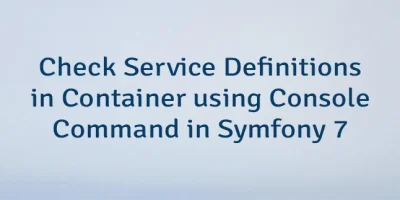Symfony framework provides many built-in commands that allow to debug various application parts. This tutorial explains how to check validation constraints for class using console command in Symfony 7 application.
Let's say we have the following class which has one property with two validation constraints:
src/Entity/User.php
<?php
namespace App\Entity;
use Symfony\Component\Validator\Constraints as Assert;
class User
{
#[Assert\NotBlank]
#[Assert\Length(min: 5)]
private string $username;
public function getUsername(): string { return $this->username; }
public function setUsername(string $username): void { $this->username = $username; }
}The debug:validator command can be used to get a list of validation constraints of a given class.
php bin/console debug:validator App\Entity\UserCommand prints information in the table:
App\Entity\User
---------------
+----------+--------------------------------------------------+---------------+--------------------------------------------------+
| Property | Name | Groups | Options |
+----------+--------------------------------------------------+---------------+--------------------------------------------------+
| username | Symfony\Component\Validator\Constraints\NotBlank | Default, User | [ |
| | | | "allowNull" => false, |
| | | | "message" => "This value should not be blank.",|
| | | | "normalizer" => null, |
| | | | "payload" => null |
| | | | ] |
| username | Symfony\Component\Validator\Constraints\Length | Default, User | [ |
| | | | "charset" => "UTF-8", |
| | | | ... |
| | | | ] |
+----------+--------------------------------------------------+---------------+--------------------------------------------------+We can provide directory name as argument to check validation constraints of all classes stored in that directory.
php bin/console debug:validator src/Entity



Leave a Comment
Cancel reply